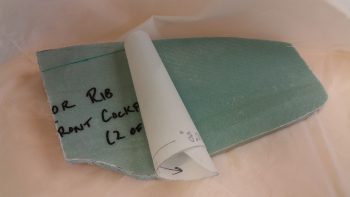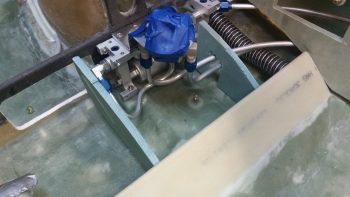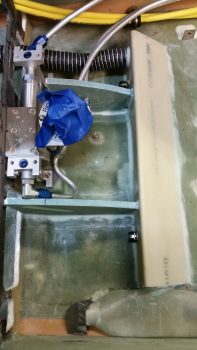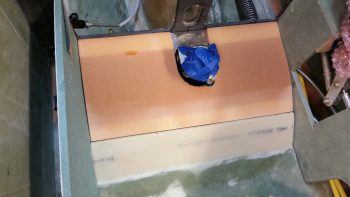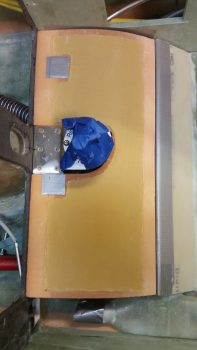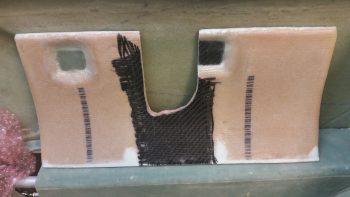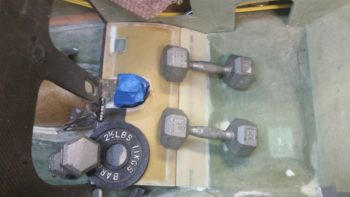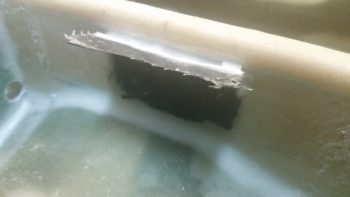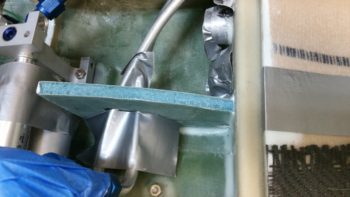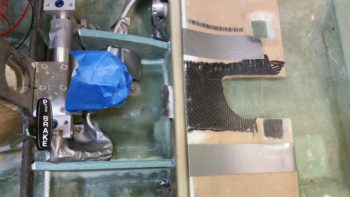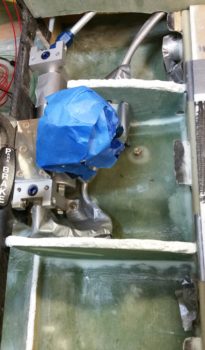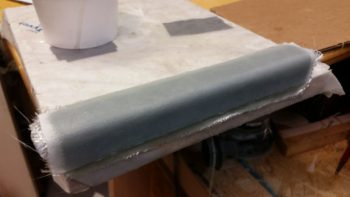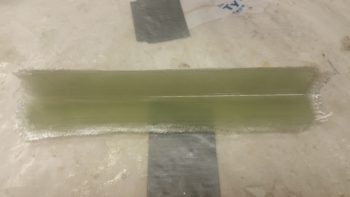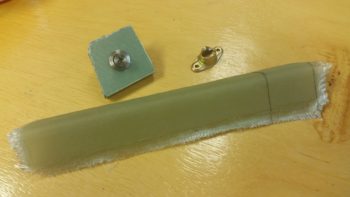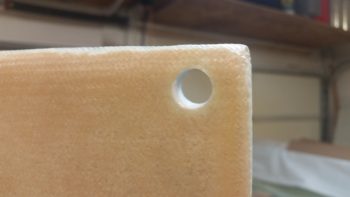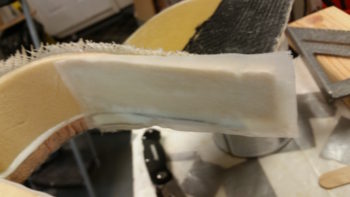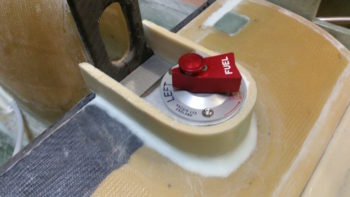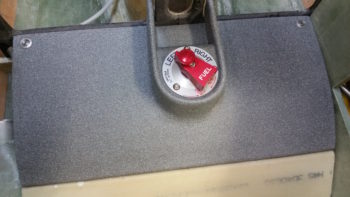Chapter 24 – Pilot Seat Thigh Support Ribs & Floor
[NOTE: The initial pilot thigh support section that makes up the left-to-right air heating vent is covered in Chapter 22 – Heating System. Also, for Fuel Selector Valve bracket construction and mounting, see Chapter 21 – Fuel System.]
3 September 2017 — I have to say that there is often a lot of research, planning and design time spent that I don’t really report on. For example, today I spent a good half hour assessing and reviewing the placement and configuration of the two pilot seat thigh support ribs. Moreover, I finalized the details on aft side of the pilot thigh support, which unlike most Long-EZs will be modified to incorporate a triangular duct across the aft edge for the right foot heater vent.
•••
14 September 2017 — Today I cut and then shaped the left thigh support rib to get it ready for glassing into place. Part of that prep involved pulling peel ply that I had applied when I laid up this piece back in mid-2012 … amazing!
Then, through the requisite trial and error fitting and sanding repeat cycle, I finalized the shape and got it into place. My original location for this rib was very close to the stock location called for in the plans.
I then spent a good hour getting the thigh support ribs configured and set in place. As I stated previously, I had originally planned on having the left thigh support rib set in place at the plans location. I even started notching the foam out to allow for the fuel pump’s left side fitting and the cross-connect fuel line to the fuel valve. After pondering it for a bit I realized that it would just take too much work both in configuring, constructing and glassing the left rib simply to keep it in place at the plan’s location. By kicking it outboard an inch to the left I eliminated all these issues & headaches…. so, that’s the spot!
On the right side there is simply no way that the rib can connect all the way from the aft side thigh support wedge duct to the bottom of the instrument panel bulkhead. Not unless I never planned on removing the fuel pump.
Now, obviously hind sight is 20/20, but had I NOT used Clickbonds on the lower fuel pump mounting tabs and instead used embedded nutplates, I could have eliminated a LOT of my fuel pump mounting issues. First, I could take the right side rib all the way to the bottom of the instrument panel bulkhead since I would have been able to slide the fuel pump in vs drop it in straight down. Even more helpful would be the fact that I wouldn’t have to remove the fuel valve bracket to get the fuel pump in or out…. the saving grace being that I don’t foresee having to be installing and/or removing the fuel pump a lot once the airplane is flying.
Here’s a wider angle shot showing all the fuel line runs in the pilot seat area, pretty much close to the original style as per plans, with some obvious distinct configuration tweaks I made on the fuel pump and fuel valve mounting locations.
I should note that the lonely Clickbond on the fuselage floor just aft of the fuel pump was originally for the 90 micron fuel filter supplied (and required) with the EFII fuel boost pump. I mounted this filter, and thus the Clickbond, prior to making my decision to go with the Holley Hydramat fuel pickups in the thigh support sump tanks. Since the Hydramats filter to 15 microns, and I have one final 32 micron filter [as required by the Silver Hawk fuel injection system] at the firewall, there is simply no need for this 90 micron filter. So…. out it went!
•••
15 September 2017 — Tonight I wanted to get at least some glass “cookin’ in the oven” so I prepped & glassed the 2 pilot seat thigh support ribs on the one side of bare foam that each rib had.
Since I had cut out a small trough in the foam for the beginning of an elongated hole on the left rib, I had to decide whether to fill it back in or leave it. I decided since I’ll be using wrenches during the installation and removal of the fuel selector valve to fuel pump main fuel feed line, I could use a bit of space between the rib and the line getting installed . . . so I left the trough. I then angled the sides of the trough sloping inwards, and pressed on with glassing the ribs.
The glassing was uneventful with 1 ply of BID going onto the right rib, and 1 ply of BID on the left. However, I did use an extra oval shaped ply of BID inside the trough and overlapping up over the edges.
Also, I didn’t micro the insert piece –that I cut out of the right rib– into the rib since I merely wanted to get a ply of glass laid up on it. The hole that you see above the insert piece is where the right and left fuel sump tank feed lines travers the rib to connect to the fuel selector valve. Once all is set and I’ve locked in the the fuel system configuration, I’ll micro the fuel lines into the rib and glass the insert piece back into place (unless I choose to glass it in from the get go).
I then peel plied the entire right rib glassed face and the edges on the left rib. After assessing the layups the right rib looked fine, but the left rib glass was having a bit of an issue staying attached inside the trough. I have to say, this is when I miss having my vacuum pump set up for vacuum bagging because this is a perfect scenario for using it. Especially since after messing around with it for a bit, I realized it wasn’t going to play nice.
So I pulled out the big gun. I covered the trough half of the layup with Saran (plastic cellophane) wrap and gently wiggled a small 4-pound sandbag into the trough, which of course overlapped onto the majority of the trough side of the rib. Sometimes taking this type of action is tricky since there may be an unknown issue that can’t be seen, but I figured keeping all the glass compacted and in place nicely with minimal delams or air bubbles would be worth the minor risk of something going awry.
•••
16 September 2017 — Today, first thing this morning, I got up and pulled the peel ply, knife trimmed, sanded and cleaned up the 1-ply BID layup on each side of the 2 pilot seat thigh support ribs that previously was bare foam.
I then made a shallow channel in the foam on the front edge of each rib. I quickly whipped up some micro paste and filled these shallow foam channels. I then covered the micro on the front edge of the ribs with a piece of peel ply, respectively.
I then left for a good 6 hours to help some friends with some heavy lifting at their community yard sale.
In the few-hour break between returning home from the yard sale and a planned outing for dinner and a movie with some friends, I quickly prepped, micro’d and then glassed the left side thigh support rib in place. In a rare occurrence, since I was going to be late, I thought I’d get gritty and earthy and throw caution to the wind by NOT peel plying the left rib BID tapes. (Note the Adel clamp mounted into the face of the pilot seat thigh support wedge duct)
A few hours later, I then prepped, micro’d in place and then glassed the right pilot thigh support rib. Since I’ll eventual reinsert and glass the lower rib notch piece –and since time was not a factor– I decided to peel ply the right side rib install layup.
Here’s a wider view of the entire pilot seat thigh support rib affair.
•••
17 September 2017 — I started out today by pulling the peel ply and cleaning up the pilot thigh support ribs. I also cut out the glass from the mouse hole on the aft side of the right rib along with the overhanging glass from the layups.
I then got to work on shaping the pilot thigh support seat floor. First, I copied the thigh support rib profile onto a template. Then I used the template to mark up a scrap piece of OSB chipboard to cut out 4 thigh support rib jigs.
I then cut out the pilot seat thigh support floor piece from 3/8″ foam, and then clamped the 4 thigh support rib jigs to the bottom of the floor piece.
I then baked the jigged & clamped pilot seat thigh support floor piece in the oven for an hour at 280°. In hindsight, it may have a been a bit too long to bake it, but in my defense there was no bake time listed in the plans!
I had to run out for a while after I turned the oven off and the floor piece started cooling down.
When I returned, I noted that there was a bit of waviness in the front & aft edges of the floor piece since the heating of the foam apparently produced some sagging in between the clamped rib jigs. Moreover, these “scalloped” edges were significant enough that I thought about scrapping this floor piece and remaking another one. But I don’t like wasting foam and to be honest, I kind of like the challenge of fixing a piece that’s less than perfect and make it work.
I pressed forward with the floor piece install and started working it until it proved to be unworkable, to see if it would . . . but it didn’t.
I wanted to lock in the CORRECT floor piece profile, so I decided to do a multi-part layup starting on the top of the floor piece surface (plans has you layup the bottom surface first). Since I needed to clamp both the front and aft edge to lock in the correct shape, I further decided to start with a large central ply of Kevlar –specifically to add puncture strength to a piece that gets stepped on every ingress & egress of the plane– and then add a strip of BID on both the front and aft edges after the center area floor piece profile was better locked into shape. After these first pieces are laid up, I’ll of course lay up a ply of BID over the entire top surface of the floor piece.
As for the Kevlar layup, I started out by microing the surface of the floor piece top where the Kevlar ply will get laid up.
I then set the ply of Kevlar in place on the top of the pilot seat floor piece.
I then wet out the Kevlar.
And then peel plied the Kevlar layup.
•••
18 September 2017 — Today I pulled off the boards that I had clamped in place to help straighten out a rather wavy looking foam piece that I shaped into a curve for the pilot seat floor piece, which also happens to make up the majority of the pilot thigh support.
I then cleaned up the initial Kevlar layup and test fitted the floor seat piece without the boards in place. It looks good, but still needs just a bit more persuasion to be close to spot on.
I also rounded the aft edge into a radius that I assessed as a “pleasing shape” since I plan on doing all glass to glass edges on this seat floor piece.
I then did the round #2 top seat floor layups on both the front and aft side of the piece, overlapping onto the initial Kevlar layup. The duct tape squares you see in these pics that you might be curious about are 2 pieces of 1.1″ x 1.1″ duct tape plies covered by another 2 plies of just slightly wider duct tape. These duct tape pads are to provide clearance on the underside of the seat floor piece for the 2 ends of the EFII fuel pump frame that juts aft. The foam over these 2 tape pads, and of course the tape itself, will be removed before I layup the underside of the seat floor.
So, at the outset of the round 2 layups, I set a square of peel ply over each of the duct tape pads and then laid up a 2″ x 2″ ply of reinforcement BID over each of the pads. I then laid up the separate front side single plies of glass (1 BID & 1 CF) to reach aft enough to cover the tape pads.
Once I got the layups completed and peel plied, I then set the seat floor back in place and clamped it again to try and knock out some of the waviness incurred by heating it up in the curve-shaping process.
You may note that I used some carbon fiber over on the left side. This is due to the fact that I had some scraps of carbon fiber hanging around, and I also wanted to really lock in that corner and tame an indention over on that side.
A few hours later, when the glass was about 90% cured, I removed the clamps and checked out the layups . . . all good! Moreover, the slight indention on the left side was in fact tamed and is no longer an issue.
I then pulled the peel ply and cleaned up the layups. Here’s a test fit of the pilot seat floor after round 2 of the top side layups.
Then it was on to round 3. I micro slurried what little bare foam was left, and made some transitions (as I had on round 2) with thicker micro between the edges of the Kevlar and the foam. I also filled in the divot created in the upper right hand corner where the clamp piece of wood made a distinct edge. I actually liked the depression, but glassing it could have been a bit difficult, so I simply filled it in with dry micro.
I then glassed the second and final ply of BID on the seat floor top. For some reason I felt like going rogue again and did NOT peel ply the entire layup, just the inside edge that will have a mini wall glassed in around the fuel selector valve.
A few hours later, after the final BID layup on the top of the seat floor cured, I then razor trimmed and cleaned up the edges, and set it back in place for a test fit. So far I’m really happy with how this is turning out. To be clear, it’s not perfect, but definitely good enough for this combat builder!
With the top done I got on with the task of shaping the front edges and sides of the underside of the foam seat floor. Just like the top aft edge, these 3 sides will have a radius that will allow the glass to curve around the edge in one continuous piece to make up the edges of the plate. Thus, every side of this seat floor plate will have micro’d corners for strength. This obviously mandated that I had to spend a bit of time making the angled trenches along literally every exterior edge (minus the center U-shaped notch) of the seat floor plate.
I then spent a bit of time as well pulling the tape & peel ply out of the divots I created for the fuel pump frame jut-outs that I needed clearance for. Once all the remnants of the last bit of “clinging-for-dear-life” peel ply was extracted (with much difficulty at times I might add!) I then used my ever trusty and ever awesome Perm-A-Grit tools to shape the foam edges of the 2 divots.
I should note that although the top was glassed with 2 plies, relatively there is so little mass in the U-shaped notched area that wraps around the fuel selector valve & bracket, that it was surprisingly “flimsy” for lack of a better word. I decided to reinforce the center narrow area with a patch of BID on the bottom side, but alas I didn’t have any scrap pieces big enough . . . but then again, I did have one last piece of scrap CF hanging around. I figured CF would provide even greater stiffness here so I threw it on there . . . at the beginning of the 1-ply BID layup on the underside of the seat floor. I know it may look a little unorthodox (read: nasty) but in my defense it’s the MGS epoxy’s fault, since if I had used EZ-Poxy you would have never known what it looked like! hahaha!
Also, before I laid up the final large piece of BID on the underside seat floor, I also again laid up a scrap patch of approximately 2″ x 2″ BID over each divot & overlapping onto the foam to add reinforcement to these glass-to-glass only areas (5 plies of glass total when all is done).
It took a bit of time just to micro slurry the foam face, and then stuff thicker micro all along the mini trenches I had created along all 4 sides. After the micro went on, to be honest, glassing up the large ply of BID was the EZ part. However, getting the glass around the corners and sticking to the edges was a bit trickier, but in the end I got it all in place.
A number of hours later, after it all cured, I then razor trimmed the glass, sanded and cleaned up all the edges.
I have to say that I’m ecstatic with how the pilot seat floor plate layups came out! I didn’t want bare foam on the edges that I would simply have to fill in with micro anyways, since if you’ve seen older plastic airplanes with bare foam edges on parts… well, they look really old, dry and unattractive (I guess that’s what folks say about us ‘ol dog pilots too, eh?!).
Anyway, here’s 3 pics showing the front, aft and side edges of the pilot seat floor plate:
I then of course mocked up the finished seat floor. Ah, it fits great!
Here’s a closeup shot of the right underside divot where you can actually see the fuel pump frame jut-out (right pic) through the glass. As you can tell, there’s plenty of clearance between the fuel pump frame and the seat floor plate.
Well, nothing left to do on this thing at this point other than try ‘er out! So I set the seat floor in place, threw a towel and some padding on the pilot seat, grabbed my throttle handle quadrant and climbed in.
This first shot is exactly what I was aiming for! The fuel selector valve is aft enough and high enough that I can actually easily see it and manipulate it during flight! Hoo-ah! Also, I should point out that my fuel selector valve bracket is only about 1/2″ max total farther aft than the stock plans fuel valve plate. The difference: my valve is located at the very aft end of the plate, obviously about an inch higher, and not located center of mass on the valve plate as the plans valve is.
I then mocked up the throttle location to test it out. I messed about with the throttle for a bit and determined that for me I had in fact picked the optimum location for this throttle quadrant setup.
Here’s a shot of the throttle handle/quadrant, fuel selector valve and control stick. Again, I’m extremely satisfied with the location, ergonomics and functionality of all these controls!
And here’s my parting shot of this post. The throttle handle and quadrant in its planned left armrest location.
•••
10 October 2017 — Tonight I wanted to get a quick layup in as a foundation for tomorrow’s build endeavors. I had originally planned to glass in 3 tabs along the top edge of the front side of the thigh support wedge duct. However, I decided to wait on the onboard tabs and focus on the middle one.
Why am I putting tabs along the front edge of the wedge duct? Well, if you think about the original plans pilot thigh support, first of all it’s actually glassed into place. Next, the most common configuration is to either have the thigh support floor/plate/top hinged on the aft side so that it swings up & aft, or at a minimum at least removable and not glassed in . . . so what do these all have in common? The aft edge of the thigh support floor/plate/top is supported along its entire length.
Mine is not.
So I just want to give a little extra support to the top plate so that it doesn’t balk at me or my pax stepping on it during ingress/egress ops!
Thus, I prepregged two sets of 2 plies of BID and decided to throw another “trash” piece of carbon fiber in the middle for added rigidity, making 5 plies total. I then wet out the glass, combined my sets into one set with the plies as follows: 2 BID/1 CF/2 BID. I set it in place, making sure it was high enough on the wedge duct, and then added a little flocro in the corner where it bent back (actually forward) away from the wedge duct.
I then placed the pilot thigh support floor/plate/top in place (with tape on the bottom where it interfaced with the glassed tab). I then weighed down the thigh support floor.
Since I used fast hardener, after a few hours it was cured. I pulled the weights and then the thigh support floor off the layup and it looked great. I had peel plied both the face and the front of the support tab, so I pulled the peel ply.
Here’s the center thigh support center support tab in it’s raw form. I should note that when I laid up the tab in place, the 5-ply glass pad measured 2″ x 2″.
I then did a quick trim on the support tab while the glass was still in its “green” state.
•••
11 October 2017 — Today I prepregged out another 2 setups of 4 plies of BID + a ply of CF. I then glassed in the outboard thigh support tabs, placed the cover back on and weighed it down.
Here’s the results a few hours later.
I then prepped the tops of both the left & right pilot thigh support ribs. The task here will be to pile up dry micro and then press it down to the correct height using the thigh support top as a form. I dug out the foam edges and then vacuumed them, plus all the foam bits scattered all about.
Here’s the whole shebang ready for some micro!
I whipped up a bunch of dry micro –after micro-slurrying the foam edges– and piled it on the top of each thigh support rib. I then placed the top back on (see a trend here?!) and weighed it down.
A couple of hours later I pulled the pilot seat thigh support top/floor off and was quite surprised at what I found. The micro was barely touched! That means A) my ribs are WAY too short! and B) my thigh support top/floor plate is way sturdier than I ever imagined!
So I cleaned up the sides of the micro piles, made them even with the rib sides, and knocked off some rough spots.
I also noted that the epoxy that I had applied to the protective duct tape on the lid wasn’t even touched… I’m still surprised at how low & off these ribs are!
I was wondering a bit on just how to glass the rib sides over the new micro, but now that I have a sense of just how high the ribs need to be (there were a scant few spots of micro that were flattened), I plan to prep the micro first, glass the sides, and then add more micro.
•••
12 October 2017 — Today I got to work on round 2 of the pilot seat thigh support rib tops. I took the profile of the bottom of the thigh support cover’s underside contour and then cut a cardboard template out so I had a good 1″ wide rib top edge profile to then cut the 1-ply prepregged BID tapes for each side of each rib.
Below you can see I’ve got the 1-ply layups + peel ply on the left rib (bottom) and on the side of the right rib, with the plastic still yet to be pulled. I know I’ll have to add around 3/16″ -1/4″ more dry micro on top of the existing micro, so I laid up these edge plies of BID so they stuck up above the existing micro a bit.
Once the layups cured for about an hour, I then trimmed them a bit, cleaned them up and then added another round of micro. I then of course had to add massive amounts of weight to the thigh support cover plate . . . Why? Because I could …. (grin)
•••
13 October 2017 — Today I started by . . . yep, adding the last bit of dry micro to the last 2-3″ middle area of each micro cap on the pilot thigh support ribs. These things looked like twins with their shiny micro midsection glaring away, untouched and unspoiled by the thigh support top plate. So, after sanding the middle micro areas on each each rib top dull, I then whipped up another round of dry micro and applied it. All in all, I seriously only needed 1/8″ to 3/16″ more micro here, but man this is one of those things in the build that wants to be stubborn!
After a few hours I finally saw what I’ve been looking for the last couple of days: no flat or untouched micro atop both my thigh support ribs… yeah! I started cleaning them up by literally shaving the sides of the overhanging micro like you would a big block of cheese.
Once I got the sides close, I then switched to a sanding block to finalize the sanding of the added micro top. I may add one more ply of BID just in the center areas for strength, but primarily to keep these from getting chipped away over the years. Regardless, this part is DONE!
•••
14 October 2017 — Today I started off with the main task of installing a CAMLOC in each corner of the pilot thigh support plate, with an associated mounting tab underneath glassed to the lower instrument panel bulkhead. Well, I quickly realized that to know exactly where the left side CAMLOC mounting was going to reside, I needed to the details of the ELT install. For example: If the ELT couldn’t be set in low enough under the thigh support, then the CAMLOC assembly might sit too low to allow clearance for the ELT and have to be mounted farther inboard. Also, if I did install the CAMLOC mounting tab, that’s just one extra extrusion to bloody my knuckles on as I worked on installing the ELT mounting bracket . . . see where I’m going with this? It’s all sequencing, right?!
Alas, it was time to work on prepping the lower instrument panel and fuselage floor for the ELT mounting bracket…
Also, since I’ll need some mounting brackets for the CAMLOCs to hold the thigh support cover plate in place, I took my 1″x1″ piece of 4130 steel and taped it to a glassing board. I then covered the top and outer edge with a piece of clear packing tape.
Then I laid up 7 plies of glass: 6 BID and 1 UNI, to make up a 1x1x8″ angled composite mounting bracket… which will of course get cut into 8 little mounting brackets. Once I laid up the glass plies, I of course peel plied the layup and left it to cure.
•••
15 October 2017 — I started off today by pulling the peel ply off of the 7-ply bracket stock, and in turned pulled the bracket stock off of the taped-up 4130 1×1″ square tubing form. As you can see, it came out just fine. I just need to sand the inside, trim it up and cut it into individual brackets.
Here’s an end view shot of the 7-ply bracket stock. Note the CAMLOC that I’ll be using the bracket stock to install.
•••
17 October 2017 — With the ELT mounting bracket “sideline project” out of the way, I started on the final task #3 of my 1-2-3 task list that I ginned up early last week for getting the pilot seat thigh support finished. In my mind this 3 item list was going to take 2 days . . . and here we are almost a week later!
Anyway, task item #3 is getting a CAMLOC installed in each forward corner of the thigh support top/cover plate (or “floor” as it’s called in the plans). I rounded up a 3/8″ thick piece of foam that was glassed both sides to mimic my thigh support cover. I also rounded up the 7-ply glass bracket stock I had made up this past weekend.
I marked the bracket stock to cut out a bracket for the CAMLOC receptacle, which I only have one for testing purposes at this point [NOTE: All my other “CAMLOC” receptacles for the engine cowlings are the SkyBolt variable adjustable type].
I then trimmed the bracket stock and lopped me off a nice bracket from it.
A bit later, here’s my 2 CAMLOC brackets for the pilot seat thigh support, with holes drilled for the receptacles. As you can see I also grabbed another stud and grommet, which I’m also testing to determine my preference.
I then drilled the stud/grommet thru-holes both left & right in the forward corners of the thigh support cover plate.
Here’s a shot with both stud/grommets in place on the thigh support cover.
I then did some multi-faceted layups. I started by slathering flocro in the thigh support corner stud/grommet thru-holes (after I prepped the holes by digging out the foam around each hole). I worked the flocro in nice and good so that it was set inside & past the edges of each hole.
A few hours later I redrilled the thigh support corner stud/grommet thru-holes for nice strong holes with very clean edges.
I needed some more surface area for my thigh support CAMLOC receptacle brackets to mount to, so as part of my multi-faceted layups I used some flocro to mount a couple ~5/16″ thick foam pieces (that I previously shaped) into the upper outboard corners of each of the panel bulkhead’s “map pockets”. I then glassed patches of BID –2 plies front, 1 ply aft– over these newly inserted corner pieces.
I then peel plied the layups and left them to cure.
A number of hours later I pulled the peel ply and razor trimmed the freshly glassed CAMLOC receptacle brackets’ backplate mounting extensions.
The last bit of glassing I did on the days’ big layup-palooza was to added 2 plies of BID to the top of each thigh support CAMLOC receptacle bracket. I noted when the CAMLOCs where in the closed/fastened/locked position, that the stud was just slightly proud of the grommet. I figured 2 plies would get me acceptably closer to a flush stud inside the grommet. Plus I’ll have paint on the thigh support cover, so I should be able to dial in the depth of the stud to match the grommet on each side.
•••
18 October 2017 — I started out today by re-drilling the holes in the pilot seat thigh support CAMLOC receptacle mounting tabs where I had added 2 plies of BID (no pic). I was ready to install the mounting tabs with CAMLOCs in place, but realized it wasn’t the best idea with only one CAMLOC receptacle on hand. Obviously I need to order one, so I added it to the small ACS order that I’m compiling.
•••
26 October 2017 — Today I received the parts from ACS that I was remiss in ordering in a timely fashion. With the #2 CAMLOC receptacle in hand I then pressed forward with the pilot thigh support cover CAMLOC locking tabs installation.
Two items worthy of note on these CAMLOC tabs is that, first, I realized I did not have countersunk rivets large enough to mount the CAMLOC receptacles to the tabs…. hmmm? I quickly determined that a #6 countersunk screw would do the trick so I rounded up some of those (I only had the fancy SS hex drive #6 screws that would work) and some locknuts and got to work.
The second issue was that the left tab would not sit flush with the lower instrument panel cross piece and that it really required some force to get the thigh support cover to seat down in its proper position. Of course I didn’t notice this until the receptacles were mounted in place and the CAMLOCs were installed tightly. I fiddled around with it for a bit and realized it just wouldn’t work with the bracket at a 90° angle since it was obvious the angle must be more acute. I don’t really like bending composite components with heat because things can go south quickly, but I bit the bullet and did just that. I used a scrap piece of wood to mount the bracket to and then judiciously applied heat and was able to bend the bracket into a more acute angle and . . . Voila! . . . worked like a champ!
Here’s another shot with the thigh support CAMLOC brackets ready to be floxed into place into the fuselage at the base of the instrument panel bulkhead.
Ahhh, this familiar site! What could it be?? Well, this time around of course it’s the thigh support CAMLOC brackets floxed into place and curing.
A bit later, after I confirmed the flox had cured, I pulled the weights off of the pilot thigh support cover and checked the fit of the now CAMLOC-secured cover. Bottom line, as my buddy Dave B. from OZ would say, “It works a treat!”
Here are the left and right CAMLOC receptacle brackets now permanently floxed in place at the base of the instrument panel.
And here’s a shot of both thigh support CAMLOC receptacle brackets.
•••
27 October 2017 — Today I got down into the shop to figure out the fuel valve skirt, pedestal, base . . . whatever it is that you’d call one of things! Since the fuel valve sits higher than the thigh support cover, then I clearly need something to keep things from falling down under the thigh support, but also I want it all to look finished as well. Another important function of this piece is that it will keep the seat cushion in place and from sliding forward.
I started by assessing and brainstorming what I needed and what I wanted. I had a general idea –obviously– but the particulars have been germinating in my mind since the day I decided to place the fuel selector valve in the location I did. After taking some measurements and playing around with the top few ideas on my list, I decided to keep the top level all the way around, so it’s basically a giant “U”, just flipped forward away from you.
I measured the depth at the back at about 1.7″, although it ended up being a bit taller on the very back part. The front was about 1.3″ high. The bottom line is that I knew that I could use some of my 2″ thick urethane foam for this task. I then made a quick thin cardboard template to figure out the lengths and slope on the bottom of the pedestal. I then used the actual thigh support cover turned upside down to get the interior shape and dimensions transferred to the foam. I then measured 0.25″ from the inside edge to give my sides, with a bit thicker area on the aft end for room to shape it around the actual fuel valve. I then used my jig saw and on VERY slow speed cut this out in a very cautious manner.
Once I got the pedestal rough top view cut out, I then marked the sides using my template. I then cut the lines to give me a straight top and angled bottomed pedestal piece.
I then tried it out on the thigh support by wrapping it around the fuel selector valve. Of course it took about 15 minutes of the trial and error fitting-sanding-fitting cycle to do this, but I fairly quickly dialed it in. A bit ironically (or stupidly!) I had the sides reaching forward where I needed them on the rough cutout and then ended up lopping them off too short! I then had to make a little extension piece for each side and use needles to keep them in place.
You may be wondering, looking at the pic below, why I’m extending the sides all the way forward . . . well, I want an area that is a little sort of a tray, or bin, if you will, to hold small bits either in flight or especially on the ground.
I then mixed up some epoxy with fast hardener and whipped up some micro. When I set the fuel valve pedestal foam piece in place I did cheat a little and used a spot of 5 minute glue about mid-point on each side. After about 5 minutes of ensuring it wasn’t moving anywhere then I finished adding the micro fillets all the way around as you see below.
I then laid up 1 ply of BID all the way up the pedestal walls overlapping down onto the seat thigh support about an inch. After ensuring the layup was all good I peel plied it since I’m going to add another ply of BID over top of it tomorrow.
 I then went for pizza & beer with a buddy of mine and we decided to go see a movie. After I returned I decided to glass the straight sections on the inside of the fuel selector pedestal so that I would have glass curing overnight. Since I used urethane foam on this, the walls are a bit flimsy and I wanted to beefen them up a bit. So I laid up 1 ply of BID on each inside straight wall of the fuel selector pedestal, peel plied them and called it a night. For now I stayed clear of the aft curved wall.
I then went for pizza & beer with a buddy of mine and we decided to go see a movie. After I returned I decided to glass the straight sections on the inside of the fuel selector pedestal so that I would have glass curing overnight. Since I used urethane foam on this, the walls are a bit flimsy and I wanted to beefen them up a bit. So I laid up 1 ply of BID on each inside straight wall of the fuel selector pedestal, peel plied them and called it a night. For now I stayed clear of the aft curved wall.
As you can see I also added some micro on the inside aft curved foam edge… actually with a little bit of cheater alcohol in it to make it much easier to sand (I learned this trick from Randi of Cozy Girrrls fame).
Here’s a shot of the interior right side glassed with 1 ply of BID (and the alcohol micro).
And shot of the right side as well.
•••
28 October 2017 — Today I started out by pulling the peel ply and cleaning up the side layups on the inside of the fuel valve pedestal base. I was going to layup the entire rest of it, but then determined that since I had decided to use thin-walled 1/4″ aluminum tubing to make up the top rounded edge that I needed an inside wall to create the “U” shaped channel, or rounded groove, along the top edge of the pedestal base.
So I glassed the aft inside wall and just as I did with the side walls, dug the foam out of the edge of the thigh support plate below and filled with dry micro. I then laid up 1 ply of BID overlapping slightly onto each of the previous interior sidewall layups.
I then put the layup under a heat lamp so that it would cure even more quickly, which it did. A little over an hour later I pulled the peel ply and cleaned up the layup.
I then sanded the top of the pedestal base to ensure the top edge was even all the way around. I then double checked the fit of the thigh support with its newly attached fuel valve pedestal in place around the fuel valve bracket.
I then spent a good half hour bending and shaping a piece of 1/4″ 3003-0 Versatube to create the top edge of the fuel valve pedestal base. I considered using Nylaflow, but it’s really hard to get it to straighten out. I also considered just shaping the foam by hand, but I changed my mind in having a bit higher edge around the fuel valve bracket, so I figured the aluminum tubing was very light and would fit the requirement nicely.
I failed to get any pics of the my ensuing tasks, but after I ensured the fit of the 1/4″ tubing was correct I then set it in place and filled in the gaps with micro and then glassed over the entire pedestal base with 1 ply of BID. I overlapped the BID ply onto the thigh support cover top about a half inch. When the layup was done I then peel plied it.
One question I had to answer was what to do on the front side of the fuel selector valve bracket, where its 6 attach screws reside. Since this area will be the floor to my little impromptu bin –when required– I figured I would simply take some spare glass I had kept around for just such purposes, make a small insert plate, and then simply use a few dabs of RTV Silicon to keep it in place until such time as I may need to remove the fuel valve bracket.
I found just such a piece of glass in my spare parts bin that looked to be about 3 plies thick. I marked out (amazing how clear this stuff is btw!) the dimensions of the cover plate on the glass piece.
And then sanded it, painted it with 2 coats of darker granite paint, then hit it with a couple coats of clear (not all in one shot, I’m jumping ahead with the pic below).
While the pedestal base layup was curing under the heat lamp, I then cut a piece of 1/16″ thick angled aluminum to create a support bracket tab that I’ll attach a nutplate to in order to allow me to secure the aft end of the cantilevered fuel valve bracket to the aft wall of the fuel valve pedestal base on the thigh support.
Here’s a closer up view of the fuel valve bracket screw support tab.
By this point the pedestal base layup was cured, so I pulled the peel ply and cleaned it up. I then spent a good half hour fitting the thigh support with its newly attached fuel valve pedestal in place around the fuel valve bracket. With the extra ply or 2 of BID on the inside of the pedestal base wall, I had to do some aggressive sanding in spots and even resorted to filing a bit of the edges of the fuel valve bracket in some spots to get things to fit! I underestimated how much clearance I would have so the fit was TIGHT! But I eventually proved myself smarter than these inanimate objects and won! ha!
I then drilled a small pilot hole for the fuel valve bracket screw support tab. I was off just a hair so I ended up making the hole bigger to use a #8 screw versus my originally planned #6 screw. With my hole drilled, I then drilled and riveted the #8 nutplate into place on the front side of the fuel valve bracket screw support tab.
After beveling the hole with a countersink, I then tested out a screw to see how it fit. I think this should do the trick nicely! Also, while the pedestal base layup was curing I primed & painted the fuel valve bracket, as you can see in this pic.
Here’s a shot of the painted fuel valve bracket in its thigh support pedestal.
I quickly mocked up the fuel valve top assemblies (no actual valve here) as well as the forward screw cover plate to see how it was all looking so far. I’m liking it!
I then sanded down and prepped the thigh support cover for a couple of lighter coats of primer. Here’s the results after the primer dried.
Then, for the grand finale of the evening, I hit the thigh support cover with a couple coats of the dark granite paint. I have to say, I really like my interior paint scheme so far.
•••
29 October 2017 — I started off this morning, which was surprisingly rain free unlike the forecast had called for, by quickly getting the thigh support cover outside. I set it up and then shot it with 2 coats of clear.
While the thigh support cover clear coat was drying, I took the opportunity to reinstall the fuel valve bracket and the actual Andair fuel valve.
A couple of hours later I installed the dry clear-coated thigh support cover. Not surprisingly, I’m super happy with how it came out, both structurally and paint-wise.
Here’s a close-up shot of the support screw that secures the fuel selector valve bracket to the thigh support fuel valve pedestal base.
I then decided to make the forward pilot seat area fuel system video that I said I would a few months back when I made the GIB thigh support sump tank video. So here it is:
•••
5 November 2017 — Today I spent about 45 minutes notching the left side of the thigh support cover plate to clear the protruding cupholder in the left armrest. However, that wasn’t the only clearance issue I had. With the armrest in place I realized I had miscalculated the required width on my thigh support cover plate by about 0.080″ wider than it needed to be if it were to fit comfortably –and be installed/removed easily– while the left armrest was installed. Thus, I ended up sanding a lot of the left edge of the thigh support cover to the point that I removed most of the edge glass down to bare foam. Ahh, such are the pains of a custom design, eh?!
I finally got the thigh support cover to fit in place without it neither protesting as it was installed nor sounding like nails on a chalkboard as the aft left corner scraped down the side of the left armrest! Note the blue tape on the thigh support cover as you can barely see the depression in the side of the installed thigh support.
•••

